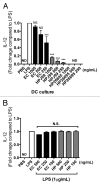Helicobacter pylori DNA's anti-inflammatory effect on experimental colitis
- PMID: 22356863
- PMCID: PMC3370948
- DOI: 10.4161/gmic.19181
Helicobacter pylori DNA's anti-inflammatory effect on experimental colitis
Abstract
Our laboratory has demonstrated a clinical inverse association between H. pylori infection and inflammatory bowel disease (IBD). In our most recent work we described a possible mechanism by which H. pylori can reduce the risk of developing IBD. Specifically, we were able to demonstrate the immuno-regulatory properties of the H. pylori genome and its ability to downregulate inflammatory responses through interaction with mucosal dendritic cells both in an in vitro and in vivo model. Furthermore, we were able to demonstrate the ability of H. pylori DNA to downregulate dendritic cell production of IL-12 and type I interferon, two pro-inflammatory cytokines. In the present work, we conducted further studies to examine the unique properties of the H. pylori genome and the exact mechanism through which it interacts with dendritic cells. Our data highlight a specific immuno-regulatory sequence (IRS), TTTAGGG, which occurs significantly more frequently as compared with other IRS sequences and is unique to the H. pylori genome. Additionally, we illustrate that H. pylori DNA has no effect on modulating the TLR-4 dependent LPS-induction of dendritic cell IL-12 production. This indicates that the inhibitory effect of H. pylori genomic DNA is restricted to the TLR-9 signaling pathway that senses bacterial DNA. In conclusion, the findings of this addendum strengthen the evidence for unique immunoregulatory properties of the H. pylori genome and revealed the importance of TLR-9 mediated mechanism in the pathogenesis of IBD.
Figures



Comment in
- Luther J, Owyang SY, Takeuchi T, Cole TS, Zhang M, Liu M, et al. Helicobacter pylori DNA decreases pro-inflammatory cytokine production by dendritic cells and attenuates dextran sodium sulphate-induced colitis. Gut. 2011;60:1479–86. doi: 10.1136/gut.2010.220087.
Similar articles
-
Helicobacter pylori DNA decreases pro-inflammatory cytokine production by dendritic cells and attenuates dextran sodium sulphate-induced colitis.Gut. 2011 Nov;60(11):1479-86. doi: 10.1136/gut.2010.220087. Epub 2011 Apr 6. Gut. 2011. PMID: 21471567 Free PMC article.
-
Development, validation and implementation of an in vitro model for the study of metabolic and immune function in normal and inflamed human colonic epithelium.Dan Med J. 2015 Jan;62(1):B4973. Dan Med J. 2015. PMID: 25557335 Review.
-
Helicobacter pylori targets dendritic cells to induce immune tolerance, promote persistence and confer protection against allergic asthma.Gut Microbes. 2012 Nov-Dec;3(6):566-71. doi: 10.4161/gmic.21750. Epub 2012 Aug 16. Gut Microbes. 2012. PMID: 22895083 Free PMC article. Review.
-
The immuno-inflammatory mechanism for tissue injury in inflammatory bowel disease and Helicobacter pylori-infected chronic active gastritis. Roles of the mucosal immune system.Digestion. 2001;63 Suppl 1:12-21. doi: 10.1159/000051905. Digestion. 2001. PMID: 11173904 Review.
-
Prior Helicobacter pylori infection ameliorates Salmonella typhimurium-induced colitis: mucosal crosstalk between stomach and distal intestine.Inflamm Bowel Dis. 2011 Jun;17(6):1398-408. doi: 10.1002/ibd.21489. Epub 2010 Oct 25. Inflamm Bowel Dis. 2011. PMID: 21560200 Free PMC article.
Cited by
-
TLR9 activation suppresses inflammation in response to Helicobacter pylori infection.Am J Physiol Gastrointest Liver Physiol. 2016 Nov 1;311(5):G852-G858. doi: 10.1152/ajpgi.00175.2016. Epub 2016 Oct 6. Am J Physiol Gastrointest Liver Physiol. 2016. PMID: 27758771 Free PMC article.
-
Helicobacter pylori: Does Gastritis Prevent Colitis?Inflamm Intest Dis. 2016 Oct;1(3):102-112. doi: 10.1159/000445985. Epub 2016 May 13. Inflamm Intest Dis. 2016. PMID: 29922665 Free PMC article. Review.
-
Influence of environmental factors on the onset and course of inflammatory bowel disease.World J Gastroenterol. 2016 Jan 21;22(3):1088-100. doi: 10.3748/wjg.v22.i3.1088. World J Gastroenterol. 2016. PMID: 26811649 Free PMC article. Review.
-
DNA Transfer and Toll-like Receptor Modulation by Helicobacter pylori.Curr Top Microbiol Immunol. 2017;400:169-193. doi: 10.1007/978-3-319-50520-6_8. Curr Top Microbiol Immunol. 2017. PMID: 28124154 Free PMC article. Review.
-
Life in the human stomach: persistence strategies of the bacterial pathogen Helicobacter pylori.Nat Rev Microbiol. 2013 Jun;11(6):385-99. doi: 10.1038/nrmicro3016. Epub 2013 May 8. Nat Rev Microbiol. 2013. PMID: 23652324 Free PMC article. Review.
References
-
- Kabir S. Detection of Helicobacter pylori in faeces by culture, PCR and enzyme immunoassay. J Med Microbiol. 2001;50:1021–9. - PubMed
-
- Stacey KJ, Young GR, Clark F, Sester DP, Roberts TL, Naik S, et al. The molecular basis for the lack of immunostimulatory activity of vertebrate DNA. J Immunol. 2003;170:3614–20. - PubMed
Publication types
MeSH terms
Substances
Grants and funding
LinkOut - more resources
Full Text Sources
